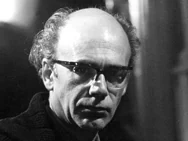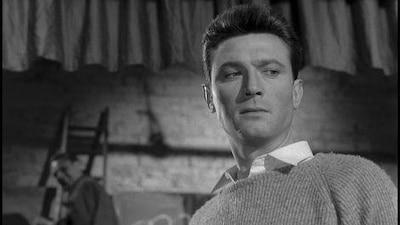Room at the Top

Brief Synopsis
Cast & Crew
Jack Clayton
Laurence Harvey
Simone Signoret
Heather Sears
Donald Wolfit
Ambrosine Phillpotts
Film Details
Technical Specs
Synopsis
In his relentless pursuit of rising up in class stature, a working-class young man in Northern England seduces a wealthy industrialist's daughter--whom he does not love--in order to marry into her wealth, but what he leaves behind is the woman whom he really loves. Subsequently, he must pay the price for his ruthless ambition.
Director

Jack Clayton
Cast

Laurence Harvey

Simone Signoret
Heather Sears

Donald Wolfit
Ambrosine Phillpotts
Donald Houston

Raymond Huntley
John Westbrook
Allan Cuthbertson
Mary Peach

Hermione Baddeley
Avril Elgar
Beatrice Varley
Stephen Jack
John Welsh
Everley Gregg
Thelma Ruby
Anne Leon
Wendy Craig
Miriam Karlin
Richard Pasco
April Olrich

Basil Dignam
Paul Whitsun-jones
Yvonne Buckingham
Doreen Dawn
Harry Moore
John Leake
Honoria Burke
Allan Bracewell
Brian Worth
Ann Gunning
Linda Leon
Mandy Priestly
Bob Palmer
Bill Morgan
Eric Louro
Pamela Manson
Ruth Kettlewell
Derek Benfield
Isla Cameron
Sandra Thompson
Kendrick Owen
Bonita Bridgeman
Kathleen Fox
Angela Culbert
Prunella Scales
Katherine Page
Anthony Elgar
Kenneth Waller
Anthony Newlands
Andrew Irvine
Derry Nesbitt
May Hallat
Sheila Raynor
Gilda Emmanueli
Jane Eccles
Denis Linford
Edward Palmer
Micheal Atkinson
Julian Somers
Richard Caldicot
Pat Lanski
Videos
Movie Clip





Hosted Intro
Film Details
Technical Specs
Award Wins
Best Actress
Best Writing, Screenplay
Award Nominations
Best Actor
Best Director
Best Picture
Best Supporting Actress
Articles
Room At the Top - Room at the Top
The British New Wave was part of the Angry Young Man movement that had begun in theater with the 1956 stage production of Look Back in Anger by John Osborne. A cultural revolt against traditional values in theater, literature, and then film, the Angry Young Man movement spoke to a generation of cynical, disenchanted, and footloose postwar youths, and it injected the British cinema with a new sense of purpose and social responsibility. Also called the "kitchen sink school," the movement focused on England's class system, shining a spotlight on the working class and lower-middle class. A naturalistic, gritty depiction of the lower classes defined these films, which is where the term "kitchen sink" derived from. Screenwriters and directors refused to paint life in the lower classes as quaint or nostalgic, dwelling on the gritty details of everyday life in tiny claustrophobic apartments where kitchen sinks were in full view.
The British New Wave films also featured groundbreaking sexual frankness in which relationships between men and women were stripped of glamour and romance. Scenes of men and women in bed shocked audiences of the day, but their candor and matter-of-fact portrayal made them relevant to a young generation who rejected middle-class morality. Another feature of these films were the antiheroic protagonists who tended to be disgruntled, self-centered men who made mistakes, acted with ruthless abandon, or became victims of their own weaknesses.
Room at the Top stars Laurence Harvey as an ambitious working class man who moves from a small, provincial factory town to the city of Warnley in Yorkshire, a bleak industrial center in the North. Joe Lampton takes a low-paying job as a government clerk, but when he spots a beautiful young woman in an expensive sports car, he is determined to have both. The woman turns out to be Susan Brown, the daughter of the richest man in Warnley, and not surprisingly, the Browns reject Lampton as a suitor for their daughter. In the meantime, Joe begins an affair with local actress Alice Aisgill, who is married to a cold, cruel middle-class businessman. Joe finds true love with Alice, but his ambition to have what the Browns have and to live on "the Top," the wealthiest district in Warnley, pushes him to seduce Susan. When Susan becomes pregnant, the Browns agree to a marriage between their daughter and Joe. Mr. Brown even sets up Joe in an important job, but Joe finds that reaching his goal comes with unexpected costs.
As the film that inaugurated the British New Wave, Room at the Top features most of the movement's main characteristics, though its attack on the class system is more direct and obvious than in later films. Some scholars and critics have criticized the film for this, complaining that it lacks the humor, lyricism, or grace of Billy Liar (1963) or A Taste of Honey (1961). Indeed, class warfare pervades Room at the Top, but as the premier film in a movement designed to attack the class system, it seems fitting to start the battle with a full frontal assault.
Not surprisingly, the upper class characters are thoroughly unlikable in their air of superiority, condescending manner, and sense of entitlement. The Browns make no attempt to hide their contempt for Joe because he is working class, while Alice's upper-middle-class husband treats her with disdain in front of her friends as a way to keep her in her "place." Those in a superior social position constantly tell Joe that he can't have what he wants. When the boss notices that Joe is looking longingly out the window at Susan Brown being whisked away in a tiny sports car, he feels compelled to remind him, "That's not for you, lad." Later, he tells Joe that if he doesn't leave Susan alone, then he won't get a promotion, adding that he should find a girl of his own "kind." Jack Wales (John Westbrook), Susan's date, recognizes the attraction between Joe and his girlfriend and sneers, "Susan's not for you."
However, Room at the Top skewers the class system, not just the upper classes. It not only criticizes a system that produces the sense of entitlement of the privileged, but it also exposes the negative effect on the working and lower classes. When Joe mispronounces "brassier," others in his middle-class crowd of friends laugh. Angered, Joe insists that he's proud to be from the working class, but he really isn't. He is not defending his class with his pronouncement of pride; he is being defensive about it. As a matter of fact, he maneuvers and manipulates to escape from being working class, a point well made by his uneducated and unsophisticated uncle when he questions whether Joe really wants Susan, asking, "You sure it's the girl and not the brass." Though Joe hates the members of the wealthy classes, he longs to be one of them because as part of the working class, he has been conditioned to want what the upper crust has and to look down on his background. Small wonder that Joe will never find satisfaction -- or peace of mind. The class system will never let him.
The film became a major box office and critical success, earning six Academy Award nominations, including Best Picture. Screenwriter Neil Paterson won an Oscar® as did costar Simone Signoret. Nominated for seven British Academy Awards, it won Best Picture and Best Film from Any Source, while Signoret won again as Best Actress. Signoret repeated her success at the Cannes Film Festival, winning Best Actress once again. More importantly, Room at the Top inaugurated the cycle of kitchen sink dramas that brought acclaim to the British cinema for the next five years, including recognition for such stellar efforts as Saturday Night and Sunday Morning (1960), This Sporting Life (1963), and Look Back in Anger (1958). The film also opened the door to stardom for a new breed of British actor with regional and working-class accents.
Room at the Top features an extraordinary cast and creative team. Harvey's portrait of a selfish, emotionally ruthless cad made him a star and destined him for future roles as cold-blooded, narcissistic antiheroes. Born in Lithuania and raised in South Africa, Harvey's distinct voice and odd accent worked to his advantage. Along with Butterfield 8 (1960) and The Manchurian Candidate (1962), Room at the Top represents his best work. Married three times and famous for living beyond his means, Harvey never seemed satisfied with his lot in life -- not unlike Joe Lampton. Producers James and John Woolf hired Simone Signoret to play Alice, with whom Joe enjoys an adulterous love affair. Most of the film's sex scenes feature Joe and Alice during their lusty liaison, and the frankness of these scenes resulted in an X certificate from the British censors. Producers John and James Woolf wanted the French Signoret for the role, partly because they did not think that British audiences would accept a homegrown actress in the part. The role of Susan Brown was played by Heather Sears, a protégée of director Jack Clayton.
Clayton's career was established by the success of Room at the Top, though he directed only eight feature films in his lifetime. Clayton did not become associated with the British New Wave like such directors as Tony Richardson or John Schlesinger, but the film does fit his penchant for adapting novels to the big screen. Also, the director worked exceedingly well with talented, high-powered actresses like Signoret. Later he directed Deborah Kerr in The Innocents (1961), Anne Bancroft in The Pumpkin Eater (1964), and Maggie Smith in The Lonely Passion of Judith Hearne (1987).
Perhaps the unsung hero of the film is cinematographer Freddie Francis, who is sometimes forgotten among Clayton and the high-powered cast. Yet, Francis's gritty black and white photography, in which the soot and grime of Warnley are almost tangible, forged the look that helped define the British New Wave.
Producers: John and James Woolf for Remus.
Director: Jack Clayton
Screenplay: Neil Paterson based on the novel by John Braine
Cinematography: Freddie Francis
Editor: Ralph Kemplen
Art Director: Ralph Brinton
Music Composer: Mario Nascimbene
Cast: Laurence Harvey (Joe Lampton), Simone Signoret (Alice Aisgill), Heather Sears (Susan Brown), Donald Wolfit (Mr. Brown), Ambrosine Phillpotts (Mrs. Brown), John Westbrook (Jack Wales), Hermione Baddeley (Elspeth), Donald Houston (Charles Soames), Raymond Huntley (Mr. Hoylake), Allan Cuthbertson (George Aisgill), Mary Peach (June Samson).
B&W-115m.
by Susan Doll

Room At the Top - Room at the Top
Quotes
Trivia
Miscellaneous Notes
Voted One of the Year's Ten Best Films by the 1959 New York Times Film Critics.
Winner of the 1959 Samuel Goldwyn Award of the Golden Globes.
Winner of the Best Actress Prize (Signoret) at the 1959 Cannes Film Festival.
Released in United States Winter January 1, 1959
Released in United States 2000
Film was shot in 1958.
Released in United States 2000 (Shown in New York City (Film Forum) as part of program "The British New Wave: From Angry Young Men to Swinging London" October 27 - November, 2000.)
Released in United States Winter January 1, 1959
Voted Best Actress (Signoret) and One of the Year's Five Best Foreign Films by the 1959 National Board of Review.














